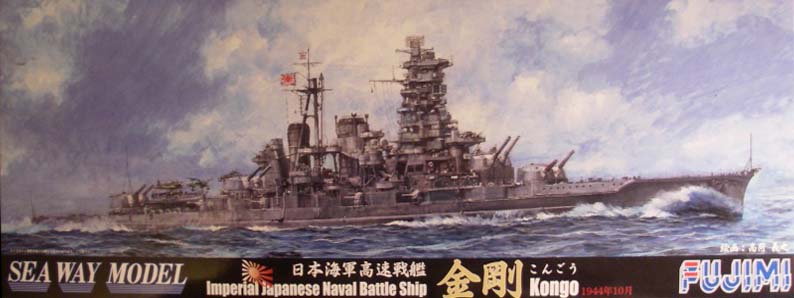|
The Imperial Japanese Navy battlecruiser
Kongo (properly transcribed as Kongō), the nameship
of a class of four, was ordered from the British Vickers shipyard, and
completed in 1913, the first ship in the world to be armed with
14 in guns. During the period between the wars, Kongo
and her sisters were modernized extensively twice, receiving slightly
better protection in a first major rebuild, and then more modern
machinery and boilers to restore the speed to 31 knots, as well
as modern anti-aircraft weaponry, in the second. At the onset of the
Pacific War in December 1941 these fast capital ships—now
reclassified as fast battleships—were the ideal close escorts
for the new fast carrier striking forces.
Kongo accompanied Japanese forces in the Malayan campaign,
and thereafter into the Indian Ocean, to Midway, Guadalcanal, Santa
Cruz, Philippine Sea and Leyte Gulf. By that time Kongo had
received several upgrades to her heavy and light anti-aircraft
armament, a surface search and air search radar fit, and a great many
of her portholes had been plated over.
At the Battle of Samar Kongo and her consorts were arrayed
against the pitifully meager USN destroyers and destroyer escorts as
Admiral Kurita's task force attempted to destroy the escort carriers
and thereafter the transports of the US invasion fleet. The Japanese
faced determined attacks from both the USN escorts and from the
aircraft of the escort carrier force, and eventually Kurita, afraid of
having his retreat cut off, broke off the engagement. During the epic
battle, Kongo helped in the sinking the USN destroyer
Hoel, the destroyer escort Roberts, the destroyer
Johnston and the escort carrier Gambier Bay.
After Leyte Gulf Kongo headed back to Japan for a refit. On
the way, near Keelung off Formosa, on 21st November 1944,
she was truck by 3 torpedoes from the USN submarine
Sealion. For fear of further attacks, the Kongo's
captain maintained speed despite the damage, whereupon more than two
hours after the torpedo hits the progressive flooding finally doomed
the ship. As she settled (some accounts say capsized) the forward
magazine blew up, sending the valiant ship to the bottom with
approximately 1250 of her crew. There were 237 survivors. Kongo
was officially struck from the IJN list on 20th January
1945.
|
|
Fujimi has released this new molding of the
Kongo as the Leyte Gulf version—in keeping with the
popularity among Japanese modelers of late-war renditions of IJN
ships. The kit is a scaled-down version of the 1/350 kit released in
2008. Accordingly—and from looking at the sprues (no sprue G
included) it was clear that at least one other version was going to be
made—and in fact recently Haruna has been announced for
release in the autumn of 2009.
The molding is very fine, and even the smaller anti-aircraft
weapons and small detail parts are extremely nicely rendered in
plastic. In a review of the Fujimi photo-etch detail set the company
released for this kit, it is noted that certain commonly found
photo-etch parts are not provided because the company believes that
the plastic parts are for the most part acceptable.
|
| SPRUE A |
|
The first sprue consists of the hull, with a
molded-on degaussing cable and finely-rendered portholes. The bow is
very sharp and my example had no warpage whatsoever.
While the hull is exquisite in all its detail, the non-vertical
edges of the casemates—carried over from the 1/350 scale
kit—are a major error. Luckily, the work to correct this is much
less than that required for the larger kit, and the angle is
furthermore far less visible in 1/700 scale.
Vertical ladders, the armour belt and both the
filled and unfilled portholes are nicely visible in the close-up
images. Especially nice to see are the fine gutters over the
portholes.
|
Click
images
to enlarge
|
 |
|
|
| SPRUE B & SPRUE F |
The second sprue consists of the deck, and I decided to go
out of order here and add the base sprue at this point of the
review.
The first thing to note is that the deck is chock-full of details,
all of a very high level of rendition, being essentially scaled down
from 1/350 scale. No doubt this will make painting the deck a little
tricky if a masking method is used.
Shields and sandbags around gun positions, a paraphernalia of
lockers and other details litter the deck surface, while the wood is
represented by nicely scribed lines and a roughened surface.
Possible the only major sections of the deck that may be improved
without too much effort are the anchor chains, which are molded
on and look much to flat.
|
 |
|
|
| SPRUE C |
|
This sprue is one of the small superstructure sprues, holding some
essential parts such as catapult, air search radar, and aircraft
crane. Also included are two launches and several davits.
The catapult, radar and crane can no doubt be
better represented using photo-etch parts. The launches are
exquisitely done.
|
 |
|
|
| SPRUE D (2X
in this kit) |
|
This sprue is provided in duplicate, and contains the main gun
barrels, secondary casemate guns, 127 mm heavy anti-aircraft
mounts, triple and twin 25 mm anti-aircraft guns, some boats,
as well as searchlights and directors.
The main gun barrels are realistically tapered and provided with
canvas blast bags pre-molded. Of course mold lines will need to be
removed, and the tips drilled out—inevitably brass barrels
lovers will replace the kit parts, but these barrels look the part out
of the box.
|
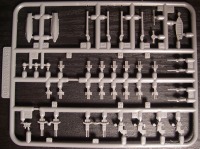 |
|
|
| SPRUE E & SPRUE P (2X
in this kit) |
|
This joined set of two sprues is provided in duplicate and is
molded in clear plastic. Sprue E contains the superstructure (total: 4)
for launches, thereby allowing the windows to be clear; sprue P
provides the F1M “Pete” floatplane (total: 2).
It is convenient of Fujimi to include clear parts for the launches,
they are certain to look good this way. I am not too sure providing
the floatplane in clear plastic is a great idea though—while the
parts are quite delicately molded, clear plastic is notoriously
brittle, and modifying or thinning parts such as the propellor is
going to be difficult. Photo-etch parts for the plane are likely to be
popular replacements.
It is too bad that only two “Pete” floatplanes are
provided, and no “Jake” as is shown prominently in the box
art. I guess that will have to come out of spares or another
aftermarket or extra detail set.
|
 |
|
|
| SPRUE H |
|
These sprues provide a large part of the superstructure and upper
deck parts, including the bridge levels and aircraft handling
deck.
The aircraft handling deck is a work of art, with fine raised lines
for the linoleum deck, and of course the aircraft handling rails, and
even the angled ladders at the edges of the deck are no longer Aztec
pyramids. While such a part—especially once aircraft are mounted
on the rails—will surely benefit from even more detail via
photo-etch sets, it is great to see such a good foundation done in
plastic. What is not so clear in the closeup shot is that the vertical
walls under the deck do not have an detail—no portholes, no
ladders, nothing. So that area is clearly something that modelers will
want to improve.
The 127 mm mount tubs provided in this sprue look smashing,
with impressive detail both inside the tub and on the underside.
In fact, similarly, closeups of some of the bridge levels show very
nice detail on the deck sections. There are some mold marks on the
undersides of several parts, but as far as I can tell not intrusive
and not difficult to remove.
The support structure for the searchlight platform behind the first
funnel is one of the best I have had the pleasure to see in 1/700
scale. I guess that photo-etch would be able to do better, but if the
parts require "thickness", then I would be more than happy
to stay with the part provided in the kit. There is one obvious but
easy to remove mold mark in the center of this part. Personally, I
find it satisfying to see a kit where such extrusions can so simply be
lopped off with a scalpel!
|
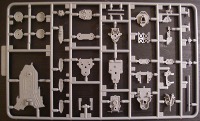 |
|
|
| SPRUE I & SPRUE R |
|
These sprues provide another large part of the superstructure and
upper deck parts, including the bridge base and forward funnel.
The massibe bridge base has the cross struts molded in, quite a
feat I have to say, given the problems of injection molding. There are
also—in contrast to the aircraft handling deck—details on
the vertical walls, including some fine doors.
The funnel has very nice details, and both funnel caps are
impressive. The support structure behind the funnel for light AA and
searchlights is realistic enough as it stands in plastic, but probably
some more effort could be made in improving it with photo-etch.
The emergency rudder is great! Finally, the supports for the range
finders ahead of the forward funnel are in two parts each, and I do
not think I have seen anyone try to depict such supports as well in
plastic as this.
The other small parts, such as anchors and surface search radar
horns, are equally to a very high standard.
|
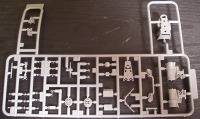 |
|
|
| SPRUE J |
|
This sprue is the final major superstructure set, and includes the
after superstructure and heavy AA platform, aft funnel, and boat boom,
among other details.
The aft superstructure and funnel have very nice side details, and
the platforms have great deck details. The boat boom is well-done, but
photo-etch will certainly improve its look.
|
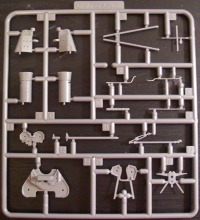 |
|
|
| SPRUE K (2X
in this kit) |
|
This sprue is provided in duplicate and contains the second portion
of the weaponry, with main turrets and single 25 mm light AA
guns.
Two patterns of main turrets are provided, one with rangefinder and
one without, as are the turret-mounted light AA platforms. The turret
detail looks good, and I believe Fujimi and the waterline consortium
are selling these sprues (and sprue D) as separate items now too. The
single 25 mm AA guns are commendably thin, and while the
barrels must no doubt be way overscale the effect is nevertheless
good.
|
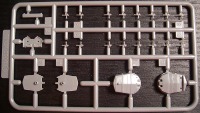 |
|
|
| DECALS |
|
A small decal sheet is provided, which is essentially for the
markings on the two provided floatplanes. You do get two IJN flags as
well. If the modeler wants decals for a third floatplane they will
have to come from somewhere else.
|
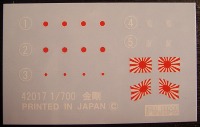 |
| INSTRUCTIONS |
|
Fujimi provides the usual single sheet of instructions, printed on
both sides and folded multiple times concertina-style.
The are almost completely in Japanese, but since there are no
variations in this kit, they should be easy enough to follow. The
first page has marking and painting instructions, showing decals as
circled numbers. Paint numbers are given for the old Gunze Sangyo, now
known as GSI Creos, laquer-based Mr. Color range in white
squares, with a table showing the equivalent numbers, in black
squares, for the aqueous Hobby Color range.
|
|
|
| CONCLUSIONS |
|
Fujimi is known as a purveyor of old kits in new boxes, making many
a modeler wary of buying anything by the company—Japanese
modelers notoriously await releases by the competition! Accuracy
issues aside though, this kit is an excellent starter for a
super-detailed and accurate late-war Kongo. The casemate issue
is probably the biggest single problem with this kit, the rest can be
taken care of with the usual upgrade fever that hits us
modelers. Pretty soon I think we will see the regular aftermarket
producers put out more detail sets and conversions. The kit is
available for 2600 JPY or less, depending on discount price. Given
that kind of price, I give it top marks in the value for money
category.
|
